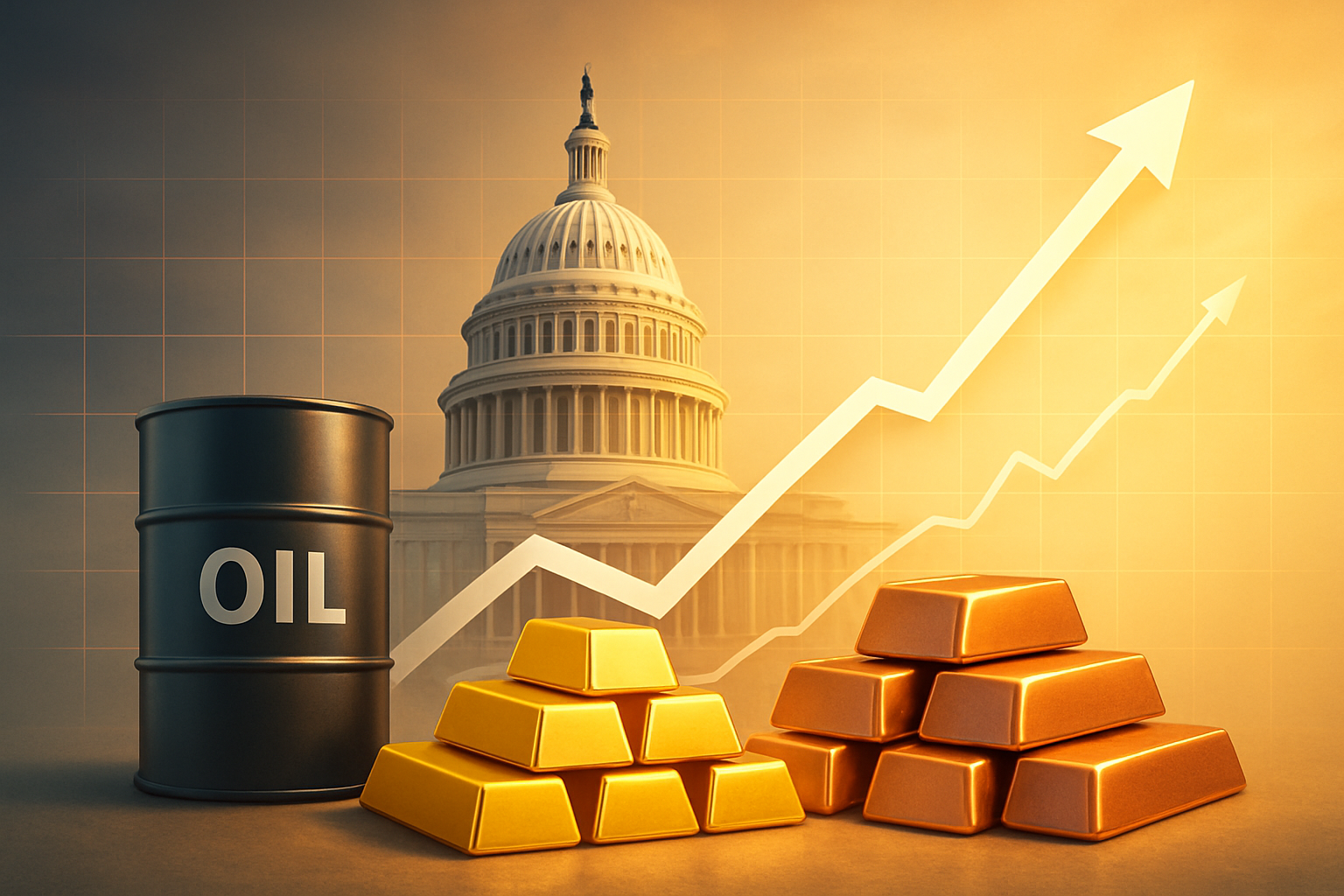
Washington D.C. – November 14, 2025 – The protracted US government shutdown, which gripped the nation for a record 43 days, concluded on November 12, 2025, with President Donald Trump signing a crucial funding bill into law. This long-awaited resolution immediately injected a wave of optimism into global financial markets, with the broader commodity sector experiencing a significant rally as investor confidence rebounded. The cessation of political gridlock has eased anxieties, paving the way for the resumption of vital economic data releases and a renewed focus on underlying market fundamentals.
The immediate aftermath saw a notable shift in market sentiment, characterized by an increased appetite for risk and a departure from defensive investment strategies. Commodities, often sensitive barometers of global economic health, reacted positively to the prospect of restored economic clarity and anticipated demand growth. Precious metals, crude oil, and industrial metals were among the early beneficiaries, signaling a collective belief that the US economy, now unburdened by the shutdown, is poised for a more stable trajectory.
Unpacking the Shutdown's End: A Detailed Look at Market Repercussions
The recent US government shutdown, the longest in the nation's history, began on September 30, 2025, stemming from a deadlock over appropriations for the upcoming fiscal year. The primary point of contention was a proposed border security funding package, which faced staunch opposition in Congress. This political impasse led to the furlough of hundreds of thousands of federal employees and the suspension of numerous government services, casting a pall of uncertainty over the domestic and international economic landscape. The shutdown's prolonged nature began to raise concerns about its potential to significantly impact GDP growth and consumer confidence.
Throughout the 43-day period, the absence of official US economic data releases, including critical inflation and employment reports, created a vacuum of information for investors and policymakers alike. This data drought complicated the Federal Reserve's assessment of the economy, leading to increased speculation about future monetary policy. Private labor data released during the shutdown had already painted a picture of a weakening US economy, which further solidified expectations among market participants for a potential Federal Reserve interest rate cut in the near future. The signing of the funding bill on November 12, 2025, by President Trump, brought an end to this period of legislative paralysis, allowing federal agencies to resume full operations and promising the imminent release of delayed economic indicators.
Initial market reactions were swift and predominantly positive. The Dow Jones Industrial Average, S&P 500, and NASDAQ all saw gains in the trading sessions immediately following the announcement of the agreement. In the commodity space, the improved risk appetite was palpable. Crude oil prices (NYMEX: CL=F) managed to secure gains, buoyed by a more positive demand outlook and the expectation of increased energy consumption as the economy normalized. Industrial metals, particularly copper (LME: HG1=LME), emerged as a significant beneficiary, reflecting renewed optimism about global manufacturing and construction activity. Precious metals, traditionally seen as safe havens, also experienced an uptick. Gold (COMEX: GC=F) and silver (COMEX: SI=F) prices edged higher, driven not only by lingering global uncertainties but also by the strengthened expectations of Federal Reserve interest rate cuts, which typically enhance the appeal of non-yielding assets. Silver, in particular, demonstrated forceful performance, clearing key resistance levels. Natural gas (NYMEX: NG=F) prices also advanced sharply, extending recent gains as traders positioned themselves for firmer demand expectations.
The key players involved in resolving the shutdown included the White House, led by President Trump, and congressional leaders from both the Republican and Democratic parties. The negotiations were often fraught with tension, highlighting the deep political divisions in Washington. The eventual resolution, a bipartisan agreement, underscored the market's strong desire for political stability and predictable economic policy, which are crucial for investment and growth. The initial market reaction clearly indicated that investors prioritized the certainty of a functioning government over the specific policy disagreements that had caused the shutdown.
Corporate Beneficiaries and Market Implications
The cessation of the US government shutdown and the subsequent commodity market rally are poised to create distinct winners and losers among public companies, particularly those with significant exposure to the energy, mining, and industrial sectors. Companies involved in the extraction and processing of the commodities that rallied most forcefully are likely to see immediate benefits, while others might experience indirect positive impacts due to improved economic sentiment.
In the energy sector, major oil and gas producers such as ExxonMobil (NYSE: XOM) and Chevron (NYSE: CVX) are expected to benefit from the uptick in crude oil prices. A more stable economic environment in the US, coupled with the anticipation of increased domestic demand for energy, could translate into higher revenues and improved profitability for these giants. Similarly, companies focused on natural gas exploration and production, like EQT Corporation (NYSE: EQT) or Southwestern Energy Company (NYSE: SWN), could capitalize on the sharp advance in natural gas prices, especially if sustained demand materializes in the coming months. The broader energy services sector, including companies like Schlumberger (NYSE: SLB) and Halliburton (NYSE: HAL), might also see increased activity and capital expenditure from producers, leading to higher service demand.
The mining sector is another clear beneficiary, particularly companies with significant copper and silver operations. Freeport-McMoRan (NYSE: FCX), a leading copper producer, stands to gain substantially from the rally in industrial metals, as higher copper prices directly impact its top and bottom lines. Similarly, silver miners such as Pan American Silver (NASDAQ: PAAS) and Wheaton Precious Metals (NYSE: WPM) could see their valuations boosted by the forceful performance of silver prices. The renewed confidence in industrial demand signals a more robust outlook for infrastructure projects and manufacturing, which are key drivers for these metals.
While the rally in precious metals might seem counter-intuitive in an environment of improved risk appetite, the underlying expectation of Federal Reserve interest rate cuts provides a strong tailwind for gold and silver. Companies like Barrick Gold (NYSE: GOLD) and Newmont Corporation (NYSE: NEM) could see continued investor interest as a hedge against potential currency devaluation and inflation if interest rates remain low or are cut. Furthermore, the overall improvement in economic sentiment is likely to bolster consumer spending, indirectly benefiting retail companies (e.g., Walmart (NYSE: WMT), Target (NYSE: TGT)) and consumer discretionary firms, although their direct link to commodity prices is less pronounced. Conversely, companies heavily reliant on stable, low commodity prices for their input costs, such as certain manufacturing or transportation firms, might face margin pressures if the rally proves sustained. However, the overall positive economic outlook stemming from the end of the shutdown is expected to outweigh these localized pressures for most businesses.
Wider Significance: A Return to Stability and Economic Clarity
The resolution of the US government shutdown and the subsequent commodity market rally represent a significant moment for the broader financial landscape, signaling a return to a semblance of political and economic stability. This event fits into a wider trend of markets increasingly valuing predictability and clear policy signals. In recent years, political volatility, both domestically and internationally, has frequently been a source of market apprehension. The successful negotiation to end the shutdown demonstrates that, despite deep partisan divides, the US political system can still find common ground to prevent prolonged economic disruption.
The ripple effects of this resolution are likely to be felt across various sectors and among international partners. For competitors, particularly those in emerging markets that rely on US economic stability, the end of the shutdown provides a more predictable global trade environment. Partners, especially those with significant trade ties to the US, will welcome the resumption of normal government functions, which supports international commerce and investment flows. The delayed release of crucial economic data had created a global information vacuum, and its imminent availability will allow for more informed decision-making by businesses and central banks worldwide.
From a regulatory and policy perspective, the episode highlights the vulnerability of the US economy to political brinkmanship. While the immediate crisis has passed, it may prompt renewed discussions about mechanisms to prevent future shutdowns or mitigate their economic impact. There could be a push for more robust contingency planning within federal agencies and a re-evaluation of the budget reconciliation process. Historically, government shutdowns, though disruptive, have often been followed by periods of market relief once resolved. Comparisons can be drawn to previous shutdowns, where markets typically rebounded as uncertainty dissipated, reinforcing the notion that markets dislike uncertainty above almost all else. The duration of this particular shutdown, however, was unprecedented, suggesting that the underlying political tensions remain a factor that investors will continue to monitor closely.
The resolution also has implications for the Federal Reserve. With economic data now set to flow freely, the Fed will have a clearer picture of the US economy's health. The market's strengthened expectation of an interest rate cut, partly fueled by weakening private labor data during the shutdown, will now be tested against comprehensive government statistics. This clarity is crucial for the Fed's dual mandate of maximizing employment and maintaining price stability, and its decisions will, in turn, influence global capital flows and commodity demand.
What Comes Next: Navigating the Post-Shutdown Landscape
The immediate aftermath of the US government shutdown's end will be characterized by a period of adjustment and careful monitoring. In the short term, market participants will keenly watch for the release of delayed economic data, including official employment figures, inflation reports, and GDP revisions. These data points will provide critical insights into the true health of the US economy and will likely influence the Federal Reserve's upcoming monetary policy decisions. If the data confirms a weakening trend, the likelihood of an interest rate cut could increase, further supporting interest-rate-sensitive assets like gold and potentially stimulating broader economic activity, which would benefit commodities.
In the long term, the primary focus will shift to the sustainability of the commodity market rally and the broader economic recovery. While the immediate relief from the shutdown is palpable, underlying economic fundamentals and global demand dynamics will ultimately dictate the trajectory of commodity prices. Potential strategic pivots or adaptations may be required from companies that were heavily impacted by the shutdown, either through disrupted supply chains or reduced government contracts. These firms might seek to diversify their client base or build greater resilience into their operations to mitigate future political risks.
Market opportunities are likely to emerge in sectors directly benefiting from increased infrastructure spending or renewed industrial activity, especially if the government shifts its focus to stimulating the economy. Companies involved in renewable energy infrastructure, for instance, could see increased investment. Conversely, challenges may arise if global economic growth slows unexpectedly or if geopolitical tensions escalate, potentially dampening the positive momentum from the shutdown's end. The ongoing trade negotiations with key partners will also be a critical factor to watch, as their outcome could significantly impact global demand for raw materials.
Several scenarios and outcomes are possible. A "best-case" scenario would see robust economic data, a well-timed Federal Reserve rate cut (if deemed necessary), and sustained global growth, leading to a prolonged commodity bull market. A "moderate" scenario might involve a gradual economic recovery with some volatility, where commodity prices remain elevated but do not experience explosive growth. A "worst-case" scenario could involve a weaker-than-expected economic rebound, further political instability, or a significant global downturn, which would likely temper the commodity rally and put downward pressure on prices. Investors should remain vigilant and adapt their strategies to these evolving conditions.
Comprehensive Wrap-Up: A Resilient Market Navigates Uncertainty
The resolution of the US government shutdown on November 12, 2025, served as a powerful catalyst for the broader commodity market, triggering a significant rally and injecting a much-needed dose of optimism into global financial markets. The key takeaway from this event is the profound impact of political stability and economic clarity on investor sentiment and asset prices. The immediate surge in prices for precious metals, crude oil, and industrial metals underscores the market's preference for predictability and its readiness to embrace risk when uncertainty recedes.
Moving forward, the market will assess the true health of the US economy as delayed government data becomes available. This information will be crucial for the Federal Reserve's monetary policy decisions, which, in turn, will continue to influence commodity valuations. Companies with strong exposure to the energy and mining sectors, particularly those involved with copper, silver, crude oil, and natural gas, are positioned to be primary beneficiaries of this renewed market confidence. However, all market participants should remain cognizant of potential headwinds, including global economic slowdowns or persistent geopolitical tensions, which could temper the current bullish momentum.
The lasting impact of this event is a reaffirmation of the market's resilience and its capacity to rebound quickly from political disruptions. While the shutdown was a stark reminder of the risks associated with legislative impasses, its resolution also showcased the underlying strength and adaptive nature of the financial system. Investors should closely monitor upcoming economic data releases, the Federal Reserve's actions, and broader global economic indicators in the coming months. A keen eye on these factors will be essential for navigating the evolving post-shutdown landscape and identifying emerging opportunities or risks within the commodity markets.
This content is intended for informational purposes only and is not financial advice







